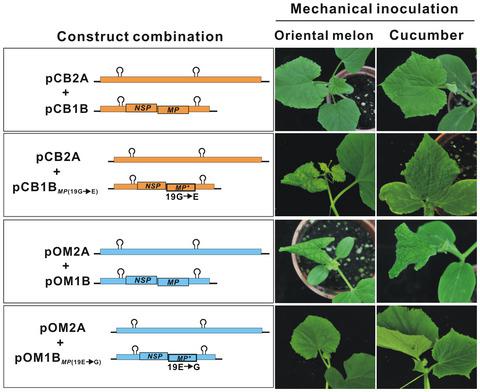当前位置:
X-MOL 学术
›
Mol. Plant Pathol.
›
论文详情
Our official English website, www.x-mol.net, welcomes your
feedback! (Note: you will need to create a separate account there.)
A single amino acid substitution in the movement protein enables the mechanical transmission of a geminivirus.
Molecular Plant Pathology ( IF 4.8 ) Pub Date : 2020-02-20 , DOI: 10.1111/mpp.12917 Chia-Hwa Lee,You-Xiu Zheng,Chin-Hsiang Chan,Hsin-Mei Ku,Chung-Jan Chang,Fuh-Jyh Jan
Molecular Plant Pathology ( IF 4.8 ) Pub Date : 2020-02-20 , DOI: 10.1111/mpp.12917 Chia-Hwa Lee,You-Xiu Zheng,Chin-Hsiang Chan,Hsin-Mei Ku,Chung-Jan Chang,Fuh-Jyh Jan

|
Begomoviruses of the Geminiviridae are usually transmitted by whiteflies and rarely by mechanical inoculation. We used tomato leaf curl New Delhi virus (ToLCNDV), a bipartite begomovirus, to address this issue. Most ToLCNDV isolates are not mechanically transmissible to their natural hosts. The ToLCNDV‐OM isolate, originally identified from a diseased oriental melon plant, is mechanically transmissible, while the ToLCNDV‐CB isolate, from a diseased cucumber plant, is not. Genetic swapping and pathological tests were performed to identify the molecular determinants involved in mechanical transmission. Various viral infectious clones were constructed and successfully introduced into Nicotiana benthamiana, oriental melon, and cucumber plants by Agrobacterium‐mediated inoculation. Mechanical transmissibility was assessed via direct rub inoculation with sap prepared from infected N. benthamiana. The presence or absence of viral DNA in plants was validated by PCR, Southern blotting, and in situ hybridization. The results reveal that mechanical transmissibility is associated with the movement protein (MP) of viral DNA‐B in ToLCNDV‐OM. However, the nuclear shuttle protein of DNA‐B plays no role in mechanical transmission. Analyses of infectious clones carrying a single amino acid substitution reveal that the glutamate at amino acid position 19 of MP in ToLCNDV‐OM is critical for mechanical transmissibility. The substitution of glutamate with glycine at this position in the MP of ToLCNDV‐OM abolishes mechanical transmissibility. In contrast, the substitution of glycine with glutamate at the 19th amino acid position in the MP of ToLCNDV‐CB enables mechanical transmission. This is the first time that a specific geminiviral movement protein has been identified as a determinant of mechanical transmissibility.
中文翻译:

运动蛋白中的单个氨基酸取代能够实现双生病毒的机械传播。
双生病毒科的贝戈莫病毒通常通过粉虱传播,很少通过机械接种传播。我们使用番茄卷叶新德里病毒(ToLCNDV)(一种二分贝戈莫病毒)来解决这个问题。大多数 ToLCNDV 分离株不能通过机械方式传播至其自然宿主。 ToLCNDV-OM 分离株最初是从患病的甜瓜植物中分离出来的,具有机械传播性,而 ToLCNDV-CB 分离株是从患病的黄瓜植物中分离出来的,则不能。进行基因交换和病理学测试,以确定机械传动中涉及的分子决定因素。构建了各种病毒感染性克隆,并通过农杆菌介导的接种成功导入本塞姆氏烟草、甜瓜和黄瓜植物中。通过用受感染的本塞姆氏烟草制备的汁液直接摩擦接种来评估机械传播性。通过 PCR、Southern 印迹和原位杂交验证植物中是否存在病毒 DNA。结果表明,机械传播性与 ToLCNDV-OM 中病毒 DNA-B 的运动蛋白 (MP) 相关。然而,DNA-B 的核穿梭蛋白在机械传递中不起任何作用。对携带单个氨基酸取代的感染性克隆的分析表明,ToLCNDV-OM 中 MP 氨基酸位置 19 的谷氨酸对于机械传播至关重要。 ToLCNDV-OM MP 中该位置的谷氨酸被甘氨酸取代,消除了机械传递性。相比之下,ToLCNDV-CB MP 中第 19 个氨基酸位置的甘氨酸被谷氨酸取代可以实现机械传递。 这是第一次将特定的双生病毒运动蛋白确定为机械传递性的决定因素。
更新日期:2020-02-20
中文翻译:

运动蛋白中的单个氨基酸取代能够实现双生病毒的机械传播。
双生病毒科的贝戈莫病毒通常通过粉虱传播,很少通过机械接种传播。我们使用番茄卷叶新德里病毒(ToLCNDV)(一种二分贝戈莫病毒)来解决这个问题。大多数 ToLCNDV 分离株不能通过机械方式传播至其自然宿主。 ToLCNDV-OM 分离株最初是从患病的甜瓜植物中分离出来的,具有机械传播性,而 ToLCNDV-CB 分离株是从患病的黄瓜植物中分离出来的,则不能。进行基因交换和病理学测试,以确定机械传动中涉及的分子决定因素。构建了各种病毒感染性克隆,并通过农杆菌介导的接种成功导入本塞姆氏烟草、甜瓜和黄瓜植物中。通过用受感染的本塞姆氏烟草制备的汁液直接摩擦接种来评估机械传播性。通过 PCR、Southern 印迹和原位杂交验证植物中是否存在病毒 DNA。结果表明,机械传播性与 ToLCNDV-OM 中病毒 DNA-B 的运动蛋白 (MP) 相关。然而,DNA-B 的核穿梭蛋白在机械传递中不起任何作用。对携带单个氨基酸取代的感染性克隆的分析表明,ToLCNDV-OM 中 MP 氨基酸位置 19 的谷氨酸对于机械传播至关重要。 ToLCNDV-OM MP 中该位置的谷氨酸被甘氨酸取代,消除了机械传递性。相比之下,ToLCNDV-CB MP 中第 19 个氨基酸位置的甘氨酸被谷氨酸取代可以实现机械传递。 这是第一次将特定的双生病毒运动蛋白确定为机械传递性的决定因素。











































 京公网安备 11010802027423号
京公网安备 11010802027423号